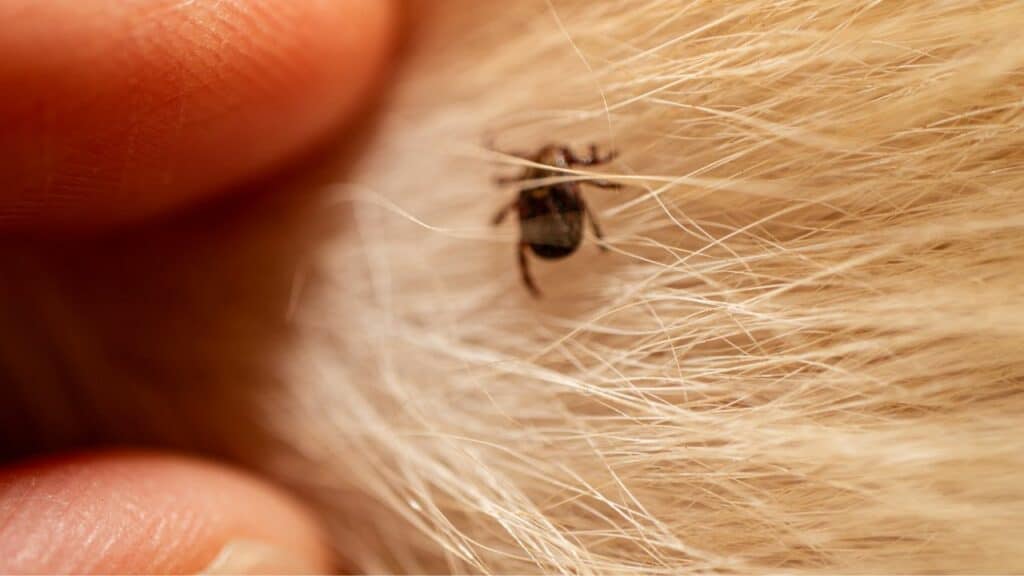As we navigate the joys and responsibilities of pet ownership, there is an often overlooked aspect that can drastically impact our canine companions’ health and comfort – the flea and tick season.
While the sight of our dogs scratching themselves may be all too familiar, and the prospect of tick-borne diseases a constant worry, we possess the power to change this narrative.
This article will serve as a comprehensive guide, arming you with the knowledge and resources to tackle flea and tick season proactively.
With these tools at our disposal, we can make every season a comfortable one for our furry friends.
Understanding Flea And Tick Season

Flea and tick season is a period typically characterized by warmer temperatures and increased humidity, conditions that provide an ideal environment for these parasites to thrive.
Depending on your geographical location, this season can vary.
However, with changing climates and indoor heating, fleas and ticks can pose a risk to your pets year-round.
The Dangers Of Fleas And Ticks To Your Dog
Fleas and ticks are more than just irritating pests.
They can transmit diseases to both pets and people.
Fleas are known to cause skin irritation, allergies, anemia, and can transmit tapeworms, while ticks can spread serious illnesses like Lyme disease and Rocky Mountain Spotted Fever.
Basic Knowledge On Fleas And Ticks

Life Cycle Of Fleas And Ticks
Understanding the life cycles of these parasites can help in effective control.
A flea life cycle consists of four stages: egg, larva, pupa, and adult, and can last from a couple of weeks to several months.
Ticks, on the other hand, have a more complex life cycle with four stages: egg, six-legged larva, eight-legged nymph, and adult.
This cycle can take up to three years to complete.
How Dogs Get Fleas And Ticks
Dogs can pick up fleas and ticks from their environment, especially areas frequented by other animals.
Fleas can jump onto dogs from infested animals or environments, while ticks often attach to dogs when they pass through tall grasses or brush.
The Risks Of Flea And Tick Infestations
Flea and tick infestations can lead to serious health complications for your dog.
In addition to causing discomfort and skin issues, heavy flea infestations can lead to anemia, especially in young or small dogs.
Ticks can transmit several diseases, with symptoms ranging from fever and lethargy to more serious complications like kidney failure.
Flea And Tick Prevention

Choosing The Right Flea And Tick Products
There are many flea and tick prevention products on the market, including topical treatments, oral medications, collars, and sprays.
The choice depends on various factors including the age, breed, health status, and lifestyle of your dog.
It’s important to consult with your vet about the distinction between products that merely repel ticks and those that actively eliminate them, as this can significantly impact your pest prevention strategy.
Environmental Prevention Measures
Beyond treating your dog, it’s essential to consider your home and yard as potential flea and tick habitats.
Regular cleaning, vacuuming, and use of environmental control products can help eliminate these pests from your surroundings.
Additionally, maintaining your yard, such as keeping grass short and removing leaf litter, can help reduce tick populations.
To prevent unwelcome visits from wildlife like deer and foxes, consider installing a fence around the area where your dog usually spends time, as these animals can carry ticks and fleas.
Regular Check-Ups And Grooming
Regular veterinary check-ups are crucial in early detection and prevention of flea and tick infestations.
In addition, regular grooming and inspection of your dog can help catch any ticks or signs of fleas early before they become a major problem.
How To Spot A Flea Or Tick Infestation

Signs Of Fleas In Dogs
Fleas are not always easy to spot, but there are signs you can look for.
Dogs infested with fleas may scratch, bite, or lick themselves excessively.
You may also notice small, dark specks (flea feces) on your dog or in their bedding.
If you’re uncertain whether dark specks in your dog’s coat are flea dirt or just dirt, perform the ‘wet paper test’: brush some onto a white paper that’s been briefly wetted; if the specks turn a rusty red color, they are likely dried blood, indicating flea presence.
Flea combs can be used to detect these pests in your dog’s coat.
Identifying Ticks On Your Dog
Ticks attach themselves to the dog’s skin to feed on their blood.
They are typically found in areas where the fur is thinner, such as the ears, groin, or between the toes.
Ticks are often confused with skin growths.
However, they can be distinguished from a wart or skin tag by closely examining where it joins the skin – the presence of black legs is a clear indication of a tick.
Common Symptoms Of Flea And Tick Diseases
Diseases caused by fleas and ticks may present various symptoms.
Flea allergies can cause severe skin irritation and inflammation, while tick-borne diseases can result in lethargy, loss of appetite, fever, lameness, and other more serious symptoms.
What To Do If Your Dog Has Fleas Or Ticks

Removing Ticks Safely
If you find a tick on your dog, it’s important to remove it promptly.
Use tweezers or a specially designed tick removal tool to grasp the tick as close to the skin as possible and pull upward with steady pressure.
If using fine tweezers usually need to pull upward. With the tick remover tools you should gently twist as you pull steadily upwards to help remove the mouthparts.
If you’re considering removing a tick but aren’t confident with the technique, we would recommend asking your vet, a vet nurse or a vet tech to demonstrate the process to ensure it’s done safely and correctly.
After removal, clean the area thoroughly.
Treating Your Dog For Fleas
A vet-prescribed flea treatment is usually the most effective way to kill fleas on your dog and prevent re-infestation.
Flea eggs can persist in the environment even after thorough cleaning, making it essential to treat all pets in the household for at least three months to break the cycle of infection.
It’s crucial not to overlook cats, as they often harbor fleas without showing obvious signs.
However, when considering flea treatment for cats, always use a cat-safe product – some treatments intended for dogs can be toxic to cats, emphasizing the importance of selecting the appropriate product for each species.
Follow the treatment instructions carefully.
Additionally, you’ll need to treat your home and possibly your yard to completely eliminate the fleas.
When To Seek Veterinary Care
If you’re unable to remove a tick, your dog exhibits signs of a flea or tick-borne disease, or if the flea infestation continues despite treatment, seek veterinary care immediately.
Your vet can provide appropriate treatment and advice.
Long-Term Management Strategies

Keeping Your Home Flea And Tick-Free
Regular cleaning and vacuuming can help keep your home free of fleas.
For ticks, keep your yard tidy and clear of tall grass and brush, which can provide a habitat for ticks.
Consider professional pest control services if the infestation is severe or persistent.
Natural Remedies For Flea And Tick Prevention
Some pet owners prefer natural remedies for flea and tick prevention, such as essential oils or diatomaceous earth.
However, these should be used with caution and under the guidance of a vet, as some natural substances can be harmful to dogs.
Strengthening Your Dog’s Immune System
A strong immune system can help your dog resist fleas, ticks, and the diseases they carry.
Healthy diet, regular exercise, and proper care can contribute to a robust immune system.
Flea and tick prevention is an essential part of responsible dog ownership.
It requires consistent effort and vigilance, but the peace of mind and health benefits for your dog are well worth it.
Always consult with a veterinarian for the best preventative measures and treatments for your furry friend.
Before You Go…
If you want to learn more, watch the following video.


